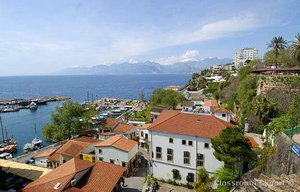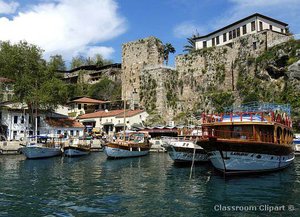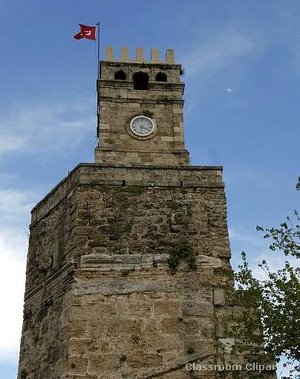Antalya
|
|
Antalya is the capital city of the Antalya Province, located on the Gulf of Antalya on the Mediterranean coast of Turkey.(Template:Coor dms). The population of the city is 603,190 (2000 census) but reaches up to 2 million in summers. Situated on a steep cliff, Antalya is a picturesque city surrounded by mountains, forests, mediterranean sea and many ancient ruins; with one notable archaeological museum. With its airport it is a gateway for Turkey's coastal resorts which took the name Turkish riviera because of the natural and historical beauties of it.
Combining history and culture it deserves the title of "the capital of Turkish tourism". Today the city of Antalya is reliving a golden age. It has been transformed into a cultural and touristic hub with thematic hotels with concepts like Venice,Topkapi Palace, Moscow cathedrals, etc... Kaleici, the rustic old town, where historic Turkish and Greek houses are under protection, is the most popular center in Antalya. It is situated between the yacht harbour and the main city. Old houses that are separated by narrow, cobble-stone roads are now hotels and tourism-related shops. Traces of Byzantine, Roman and Seljuks architecture and culture can still be seen. Also Antalya museums house the finds belonging to historic ages of Anatolia.
Inside the city Yivli Minare and Kulliye, Karaalioglu park are places where Ottoman architecture can be seen. Konyaalti and Lara coasts are well known with their crystal clear waters. The prominent sites accessible by daily tours are Side, Perga, Manavgat and Alanya. Ancient cities like Phaselis, Olympos, Adrasan and Kekova can be reached from the sea by Blue voyagers.

| Contents [hide] |
Etymology
In the 1st century BC, the Pergamum king Attalos II ordered his men to find the most beautiful piece of land on earth; he wanted them to find "heaven on earth". After a long search all over the world, they discovered this land and said "This must be 'Heaven' " and King Attalos founded the city giving it the name "Attaleia" (Greek: Αττάλεια) which later became Adalia and then Antalya.
History
Evidence of human habitation dating back over 200 000 years has been discovered in the Carain caves 30 km to the north of Antalya city. Other finds dating back to Neolithic times and more recent periods show that the area has been populated by various ancient civilisations throughout the ages.
Records from the Hittite period (when the first recorded political union of Anatolian cities was set up calling itself the Lycian league) refer to the area as the "Lands of Arzawa" and document the lively interaction going on between provinces in 1700 BC.
Historical records document how cities developed independently, how the area as a whole was called Pamphylia and how a federation of cities was set up in the province. There is also a record of the migration of the Akha clan to the area after the Trojan war.
Antalya had entered the sovereignty of Lydian Kingdom from 7th century BC. The reign of the kingdom of Lydia in west Anatolia came to an end in 560 BC after it was defeated by the Persians during the battle of Sardis in 546 BC. The Macedonian commander Alexander the Great stoped the Persian rule and in around 334 BC Alexander the Great conquered the cities of the area one by one - except for Termessos and Sillyon which managed to repulse his armies in 333 BC. Antalya itself was founded later. With the death of Alexander in 323 BC, a long battle erupted between his commanders that lasted until 188 BC.
With the defeat of the Seleucid army at Apamaea began the reign of the kingdon of Pergamom. In 150 BC Attalos II, king of Pergamom, founded the city of Attalia (Greek: Αττάλεια—present day Antalya) to base his powerful naval fleet. When Attalos III, the last king of Pergamom, died in 133 BC he left his kingdom to the Romans. After that an era starts in the region that the pirates and small cities belonging to pirates play a major role. Christianity started to be spread in the region after 2nd century. During the Byzantine sovereignty, it is known that Antalya had a big development era until 5th and 6th centuries. In these centuries, Antalya had reached beyond the city walls. Starting from 7th century, the Muslim Arabs had started to be dominant in the region. The army of Louis VII. sailed thence for Syria in 1148, and the fleet of Richard of England rallied there before the conquest of Cyprus. Between the years 1120-1206, Antalya had agained passed under the sovereignty of Byzantines. Antalya played a considerable part in the medieval history of the Levant. Kilij Arslan had a palace there.
Conquered by the Seljuk Turks of Konia in 1207 A.D. and then Alanya in 1220 A.D. ending the Byzantine rule for the last time, and made the capital of the province of Tekke, it passed after their fall through many hands, including those of the Venetians and Genoese, before its final occupation by the Ottoman Turks under Murad II. (1432).
The Arabic traveller Ibn Battuta who came to the city in between 1335-1340 noted:
- "The people of the city are living in separate neighborhoods according to their ethinicity and religion. The Christian merchants are living in a neighborhood called Mina. The neighborhood is surrounded by a wall and the gates of the walls are closed on Friday nights. The Greeks live in a different neighborhood and it is also surrounded by a wall. The Jews also have their own neighborhood surrounded by walls. The Muslims are living in the largest part. This part includes a small mosque and madrasah with a lot of hamams, rich, organized and large bazaars. The city is surrounded with a large wall that includes all of the neighborhoods that we mentioned above."
In the 18th century, in common with most of Anatolia, its actual lord was a Dere Bey. The family of Tekke Oglu, domiciled near Perga, though reduced to submission in 1812 by Mahmud II., continued to be a rival power to the Ottoman governor till within the present generation, surviving by many years the fall of the other great Beys of Anatolia. The records of the Levant (Turkey) Company, which maintained an important agency here till 1825, contain curious information as to the local Dere Beys. The population as of 1911 of Antalya, which included many Christians and Jews, then living, as in the middle ages, in separate quarters, the former round the walled mina or port, was about 25,000. The port was served by coasting steamers of the local companies only. Antalya(then Adalia) was an extremely picturesque, but ill-built and backward place. The chief thing to see was the city wall, outside which runs a good and clean promenade and which survives to this day. The government offices and the houses of the better class were all outside the walls. [1] (http://en.wikisource.org/wiki/EB1911:Adalia)
The brief occupation of the area by the Italians came to an abrupt end after the First World War with the founding of the Turkish Republic in 1923. The area is now registered as a province of the Republic of Turkey.
A notable historical figure who visited Antalya was Paul of Tarsus, as recorded in the biblical book, the Acts of the Apostles (Acts 14:25-26), wherein Antalya is referred to as Attalia. St. Paul and St. Barnabas went to Antalya and sailed from there to Antioch after preaching in the Pisidia and Pamphylia regions.
Climate
Okhan_de_lan_Antalya_20042.jpg
The climate in Antalya bears the Mediterranean climate features. The mild weather conditions offer holiday possibilities in all seasons. Sometimes you can experience in Kemer four seasons in one day. 300 days of the year are sunny. This causes Antalya to be one of the few cities in Turkey to use solar systems for energy needs of buildings.
In summer time it is rainless and hot. In winter time it is rainy and mild. No snow falls to the coastline of the district. The mountains in the north and the mild wind from the south are reasons why it usually goes never below 10 °C in this region. With the exception of a few weeks of rainy days, the seawater, which goes even in winter not below 15 °C allows you to benefit from the sea all year long.
- Rainy season: from October to April, dry in the summer
- Avg. Temp. in Spring: max.: 17 – 25 °C ( 63 - 77 °F ); min: 7 - 14 °C ( 45 - 57 °F )
- Avg. Temp. in Summer: max.: 30 – 33 °C ( 86 - 92 °F ); min: 19 - 22 °C ( 66 - 72 °F )
- Avg. Temp. in Autumn: max.: 20 – 31 °C ( 68 - 88 °F); min: 10 - 18 °C ( 50 – 64 °F )
- Avg. Temp. in Winter: max.: 14 – 15 °C ( 57 - 59 °F); min: 5 - 6 °C ( 41 - 43 °F )
- Watertemperature: in summer around 29 °C (85 °F) in winter about 17 °C (63 °F)
| Parameter | Jan | Feb | Mar | Apr | May | Jun | July | Aug | Sep | Oct | Nov | Dec |
|---|---|---|---|---|---|---|---|---|---|---|---|---|
| Ø air temperature °C | 10.6 | 11.1 | 12.8 | 16.1 | 20.6 | 24.7 | 28.3 | 27.8 | 25.0 | 20.9 | 16.4 | 12.2 |
| max. air temperature °C | 15.0 | 15.6 | 17.8 | 21.1 | 25.6 | 30.0 | 33.9 | 33.3 | 30.6 | 26.7 | 21.7 | 16.7 |
| min. air temperature °C | 6.1 | 6.7 | 7.8 | 11.1 | 15.6 | 19.4 | 22.8 | 22.2 | 19.4 | 15.0 | 11.1 | 7.8 |
| Ø hours of sunshine | 149 | 185 | 223 | 255 | 326 | 366 | 397 | 375 | 321 | 267 | 198 | 158 |
| Ø water temperature | 17 | 17 | 17 | 18 | 21 | 24 | 27 | 28 | 27 | 25 | 22 | 19 |
Krem2.jpg
Festivals
Where: Antalya When: 12-29 September, 18 days
Where: Antalya When: Last week of September
Where: Antalya When: 5-11 October, 6 days
Where: Gündogmus When: 15 August, 1 day
Where: Antalya When: Last week of August
Where: Aspendos When: 10 June, 22 July
Where: Ataturk Cultural Center When: 20-26 October
Where: Ataturk Cultural Center When: 2 7 September
Where: Antalya Beachpark When: 17-19 October
Where: Kas-Demre When: 4-8 December, 5 days
Where: Kumluca When: 18-20 May, 3 days
Fairs
Where: Antalya Expo Center When: 21-24 February
Transportation
- By Air: The Antalya International Airport connects the city to most capitals of the world. Between the airport and the city center the Airport Service Bus is in use.
Airlines (Listing of Airlines servicing Antalya)
- By Bus: The bus system has transportation to almost every city in Turkey which depart from the Antalya Bus Station(Otogar).
- By Ferry
The Antalya-Venice Ferryboat line is currently in use. The expansion of routes of Highspeed ferries are currently being worked on.
Innercity Transportation:
- Bus: The bus system has access to almost all the parts of the city.
- Dolmus:
Dolmus literally means "filled up". Dolmus is a large cab, a station wagon, a regular taxi or a minibus hat travels a certain route. Most major public transportation stations have a dolmus station, where you just take a seat in the dolmus that travels your desired route. The driver will wait until the dolmus is full, before the journey begins. Passengers pay according to the distance traveled and can get in and out whenever and wherever they want to by informing the driver. It is a very practical means of transport and much cheaper than a taxi. The dolmus fares are determined by municipalities according to distances.
- Taxis:
Taxis are numerous all over Turkey and are recognizable by their yellow color and lighted "taxi" signs on top. Each taxi is metered and there are two different rates. After midnight (24:00) till morning (06:00) it will cost 50% more than the daytime fare.
- Tramway:
The single tram line starts at the Antalya Museum, Antalya Beach Park (at Konyaalti Beach), and the Sheraton Voyager and Falez hotels in the west, and runs eastward along the main boulevard to the city center at Kalekapisi. Then it turns right (south) and passes Hadrian's Gate and Karaalioglu Park before passing near the deluxe Talya Oteli and ending near Lara Plaj (Beach) to the east.
There are only two trains. They run along a single track, passing at a short length of double track near Kalekapisi.
Both trains depart on the hour and half-hour from the termini (east and west), and reach Kalekapisi between 10 and 15 minutes later. The one-way fare is under $1.
Tourist Attractions
Sites of Interest in the city
Yivleminare.jpg
Kaleici: It is the historical center of the city which embraced many civilizations during time. It is now restored and has became a most attractive touristic centre with its hotels, bars, clubs, restaurants, and shopping. Kaleici retains all the original ancient Turkish archaeological characteristics. The port's marina has been completely restored. The restoration activities in Kaleici won the Golden Apple Prize, the Oscar of tourism.
The City Walls: The memorial Hadrian Arch and The Clock Tower are remarkable and date back to Hellenistic era.
Antalya Museum (http://www.kultur.gov.tr/portal/arkeoloji_en.asp?belgeno=2952): A prize winning museum and one of the most notable archaeology museums, of the world. It is also the only museum in Turkey with a children's department exhibiting ancient monuments appealing to children.
Kaleiçi Museum (http://www.kaleicimuseum.org/): Opened by the Mediterranean Civilizations Research Center (Akdeniz Medeniyetleri Araştırma Merkezi) it is newly opened and already has a very rich collection.
Hadrian's Gate: This ornamental marble arch was constructed in 2nd century BC by the Romans in honour of the Emperor Hadrian.
Kesik Minare (Broken Minaret): Once a Byzantine Panaglia church, later converted into a mosque.
Yivli Minare (Fluted Minaret): This fluted minaret of 13th century was built by the Seljuks. Decorated with dark blue and turquouise tiles, the minaret eventually became the symbol of the city.
Karatay Medresesi, Hidirlik Tower, Ahi Yusuf Mescidi, Iskele Mosque, Murat Pasa Mosque, Tekeli Mehmet Pasa Mosque, Balibey Mosque, Musellim Mosque, Seyh Sinan Efendi Mosque and Osman Efendi Mosque are other important places in the city.
"Han"s are Seljuk or Ottoman inns which have architectural significance. Some of them are the Evdir Han, Klrkoz Han, Alara Han and Castle and Sarapsu (Serapsu) Han.
- Lara Beach Park
- Demre mineral springs
- Karpuzkaldıran
- Konyaaltı Beach Park
- Duden Falls
- Kursunlu Falls
- Köprülü Kanyon
- Düzler pine forest
- Saklikent Ski Center
- Kalkan
- TünekTepe
Historic sites and Ruins around the city (see Antalya Province for the complete list of all ancient cities in the Region)
Aspendos: One of the most important Pamphilian cities. It is situated on the point where the Kopru River meets the sea. Once an important port and a commercal centre, it has a reputation for raising the best horses on earth. The odeon, basilica, galleria and fountains are worth seeing.
Termessos: It is a Pisidyan city with remnants of an agora, theatre and an odion. It has a reputation of being the most magnificent necropolis on the Mediterranean, 35 km northwest of Antalya.
Ariassos: At a distance of 48 Km. along the Antalya Burdur highway and before arriving at the village Dag, turn left and Ariassos is reached 1 Km. further on. A city of antiquity, Ariassos was built in a valley and could survey its surroundings. The gate, the baths, the rock tombs and the mausoleum are almost intact.
Olympos National Park: Olympos is an ancient Lycian city 90 km southwest of Antalya city near the Town of Kemer.
Perge: 18 km northeast of Antalya. The ruins are spread on two hills, the theatre on one and the acropolis on the other. According to the legend the city was built by three heros from Troy.
Phaselis: A Lycian city 54 km southwest of Antalya.
Sillyon: 34 km from Antalya on the Alanya direction. It is situated between Aspendos and Perge and dates back to 4th.century BC.
Sagalassos: An ancient pisidian town 100 km north of Antalya.
Economy
Main growth and development of Antalya started in the Republic era. While the town population was 17.635 in 1927, 27.515 in 1950, 50.908 in 1960,it reached 95.616 in 1970. The population which was 258.139 In 1980,reached 1.719.751 in the year 2000.
It's magnificent nature, suitable climate conditions increased the migration to the city. While the migrations caused new districts in the city, it fastened the construction sector. The agriculture sector which showed development parallel with tourism, it caused transportation sector to be developed with itself.
The main stones of the economical structure of Antalya is tourism, agriculture, commerce and industry. In the city which has a wide range of agricultural production from citriculture to forcing vegetables, from cotton to flower growth, most of the people earn their income from tourism and agriculture. (Specially famous with its Orange and Banana)
Famous people from Antalya
alphabetical order
- Tarık Akıltopu - Architect, Historian, Poet, Writer
- Cafercan Aksu - Football player
- Nurdan Arca - Movie Director
- Deniz Baykal - leader of Turkish Republican People's Party (CHP)
- Turgut Cansever - Famous Turkish architect
- Baki Süha Edipoğlu - Writer, Poet
- Şener Kökkaya - Actor
- Saint Nicholas - also known as Santa Claus, lived in the ancient town of Myra
- Özgürcan Özcan - Football player
- Rüştü Reçber - Football player
- Menderes Türel - Politician, current mayor of Antalya
- Levent Yüksel - Musician, Composer
- Lütfi Ünsal - Headmaster, TED College Antalya Branch
External links
AntalyaSunset.JPG
- WikiSatellite view of Antalya at WikiMapia (http://www.wikimapia.org/#y=36873304&x=30710735&z=13&l=1&m=a)
- Governorship of Antalya (http://www.antalya.gov.tr/eng.htm)
- Metropolitan Municipality of Antalya (http://www.antalya.bel.tr/en)
- Ministry of Tourism Pages (http://goturkey.kultur.gov.tr/destinasyon_en.asp?belgeno=9573&belgekod=9573&Baslik=Antalya)
- Antalya Weather Forecast Information (Turkish Meteorology Service) (http://www.meteor.gov.tr/2003/iller/ilarae.asp?adi=antalya)
- Detailed Weather Forecast (http://www.turkeyforecast.com/weather/antalya/)
- Ministry of Tourism Pages (http://goturkey.kultur.gov.tr/destinasyon_en.asp?belgeno=9573&belgekod=9573&Baslik=Antalya)
- Setur Antalya Yacht Marina (http://www.seturmarinas.com/english/english.html)
- Antalya Website (http://www.antalya-ws.com/)
- Website of TUBITAK National Observatory in Antalya for the eclipse on March29 (http://www.tug.tubitak.gov.tr/)
- Various Antalya pictures from Wowturkey (http://www.wowturkey.com/forum/viewtopic.php?t=4237)
- Wowturkey Antalya photos forum category (In Turkish) (http://www.wowturkey.com/forum/viewforum.php?f=11)
- Historic Antalya photos (http://www.wowturkey.com/forum/viewtopic.php?t=10776)
- Pictures of Kaleiçi (http://www.wowturkey.com/forum/viewtopic.php?t=6953)
- Pictures of this city (http://www.pbase.com/dosseman/antalya_turkey)
- Antalya Guide and Photo Album (http://www.anatolia.luwo.be/Antalya.htm)
- Pictures of Antalya (http://www.turkishclass.com/turkey_pictures_gallery_11)
- Antalya, Turkish Folk Music (http://www.turkudostlari.net/search.asp?b=3168&x=2)
- About Antalya (http://www.aboutantalya.net)



